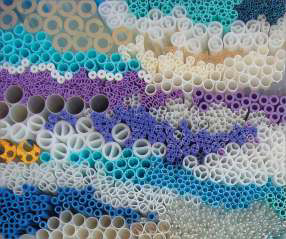|
Medical Plastics
Tubing: Applications, Quality, & Extrusion Process
Challenges
The focus for this issue is the most dynamic area in the
medical device sector - medical tubing and extrusion
technology. The medical device industry contributes
significantly to the healthcare industry as well as the
patients in improving the quality of healthcare services
by way of reducing procedure and hospitalization times,
and patients’ trauma, while improving outcomes. This is
possible because of advancements offered by medical tube
manufacturers by way of more properties, more material
options as well as more precise process control which in
turn results in improved medical device designs. A good
understanding of polymer science and behaviour of
polymer materials is very important in order to get high
quality medical tunings. A very detailed overview on
various techno-commercial aspects related to medical
tubing and extrusion technology is covered in this
issue.
 Medical Tubing and Extrusion Technology Medical Tubing and Extrusion Technology
The medical tubing segment comprises the most dynamic
area in the medical device landscape. The market of
plastic Tubing is expecting significant growth due to
changing global demographics and the growth of medical
procedures such as minimally invasive surgeries.
As per “Markets & Markets” , the global Medical Tubing
market was valued at US $ 4.9 billion in 2021 and is
projected to reach US $ 7.9 billion by 2026 , growing at
a CAGR 10 % .
Primary drivers of the global market for medical tubing
are rapidly increasing geriatric populations, the
increasing demand for medical devices that incorporate
tubing, the growing access to health care around the
globe, which carries with it a market for medical
devices and the tubing associated with those devices and
minimally invasive surgeries.
Critical Applications
Plastic tubing plays a pivotal role in many advanced
medical procedures, such as vascular catheters, conduits
for acquiring biopsy samples, and holders for stents
being implanted into heart arteries. Minimally invasive
techniques such as angioplasty drove the need for tubing
with small diameters and thinwalls, temperature control
became critical for maintaining tight dimensional
tolerances. Other Examples of tubing applications
include high-pressure catheter tubing, stent-delivery
catheters, and balloon tubing used in medical balloons,
especially stent delivery balloons. Examples of markets
that rely heavily on tubing technology include the
following:
• Neurovascular (e.g., treatment of stroke).
• Cardiovascular (e.g., angioplasty, stenting, cardiac
ablation, and mitral valve repair).
• Peripheral interventions (e.g., stent grafts, venous
therapy).
• Endoscopic and renal denervation applications
• Implants (e.g, inferior vena cava filter, and
prosthetics valves).
Material, Process & Quality Requirements For
High-Quality Extruded Tubing
A good understanding of polymer science and the behavior
of polymer materials is extremely important for
achieving high quality extruded tubing. Polymer material
suitable for medical tubing should have: Inertness to
body tissues and fluids, Flexibility, Resistance to
sterilization conditions, Low extraction, Clarity and
Low cost for high volume applications.
PVC, with the advantages of combination of performance
and costs is the most widely used plastic medical tubing
material. Polyethylene is the second largest material in
medical tubing based on volumes consumed. TPE,
polyamide, silicone, fluoropolymer and PEEK also find
specialized niches in tubing systems. PP and PC are also
used as medical tubing materials.
The following table highlights commonly used medical
polymers and their respective major applications.
Medical Tubing And
Extrusion Technology
| Sr. |
Materials |
Common Applications |
Sr. |
Materials |
Common Applications |
|
1 |
Polyvinyl Chloride PVC |
Containers used for
blood and blood components for urine or for ostomy
products and tubing used for blood taking and blood
giving sets, catheters, heart-lung bypass sets,
haemodialysis set etc. |
9 |
High Density
Polyethylene LDPE |
Embolectomy, Guidewire
dispensers, Introducers, Protective tubes,
Thrombectomy, Sheaths and dilators for introducers,
Coextruded perfusion tubing, Aspirator tips |
|
2 |
Polytetrafluoroethylene,
PTFE |
Catheter liner,
Electrical Insulation, Fluid transfer,
Telecommunication |
10 |
Low Density Polyethylene
LDPE |
Embolectomy, Guidewire
dispensers, Introducers, Protective tubes, Throbectomy |
|
3 |
Fluorinated Ethylene,
Propylene, FEP |
IV catheter, Regional
Anesthesia, Vascular access |
11 |
Polyurethane PUR
(Aliphatic) |
Angiography, Cardiac
catheters, Central Venous catheters, Dialysis,
Epidural catheters, IV catheters, Epidural probes,
Catheters, High-pressure lines |
|
4 |
Ethylene
Tetrafluoroethylene, ETFE |
Fluid transfer, IV
catheter, Electrical insulation |
12 |
Polyurethane
PUR(Aromatic) |
Angiography, Cardiac
catheters, Central Venous catheters, Dialysis,
Epidural catheters, IV catheters |
|
5 |
Perfluoroalkoxy, PFA |
Fluid transfer, In Vitro
diagnostics |
13 |
Polypropylene PP |
Guidewire dispenser
tubes and Protective tubes |
|
6 |
NYLON, 6, 11, 12 |
Angiography,
Choloecstectomy, Epidural catheter, Laparoscopic
instruments, Radiology |
14 |
Ethylene Vinyl Acetate
EVA |
Endotracheal,
Embolectomy, IV therapy, Suction catheter |
|
7 |
Polyether Block Amide,
PEBA |
Angiography,
Cholangeography, Epidural Catheter, Radiology |
15 |
ACETAL |
Laparoscopy, Guiding
catheter |
|
8 |
Polycarbonate PC |
Laparoscopic
instruments, IV therapy, Laparoscopic cannulae, Tube
packaging, Microtubes |
. |
